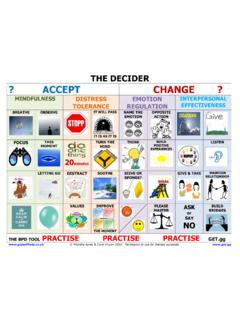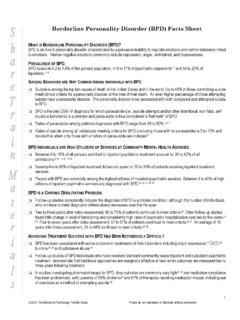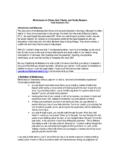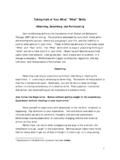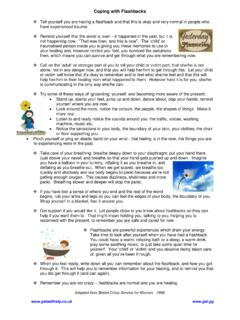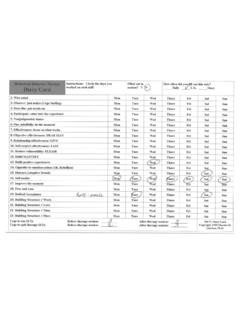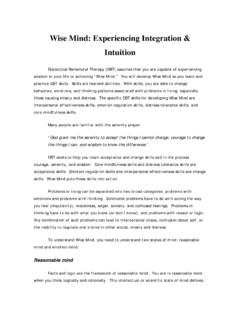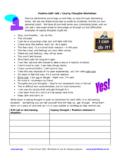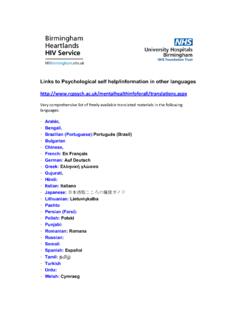Transcription of Page 1 3 ANXIETY - DBT Self Help
1 Page 1 of 3 vivyan 2009 ANXIETY ANXIETY is the body's way of responding to being in danger. Adrenaline is rushed into our bloodstream to enable us to run away or fight. This happens whether the danger is real, or whether we believe the danger is there when actually there is none. It is the body's alarm and survival mechanism. Primitive man wouldn't have survived for long without this life-saving response. It works so well, that it often kicks in when it's not needed - when the danger is in our heads rather than in reality. We think we're in danger, so that's enough to trigger the system to go, go, go!
2 People who get anxious tend to get into scanning mode - where they're constantly on the lookout for danger, hyper-alert to any of the signals, and make it more likely that the alarm system will be activated. Thoughts that often occur relate to our overestimating or exaggerating the actual threat and underestimating or minimising our ability to cope: I'm in danger right now The worst possible scenario is going to happen I won't be able to cope with it Physical Sensations - The Adrenaline Response When there is real, or we believe there is a real, threat or danger, our bodies' automatic survival mechanism kicks in very quickly. This helps energise us to fight or run away ('fight or flight response'). We will notice lots of physical sensations, which might include: Heart racing - This helps to take the blood to where it is most needed the legs so that we can run faster (flight); the arms so that we can hit out (FIGHT); the lungs to increase our stamina.
3 At the same time blood is taken from the places it is not needed for example fingers, toes and skin. These changes cause tingling coldness and numbness. Breathing gets faster - This helps the bloodstream to carry oxygen to the arms, legs and lungs. This will give us more power. The side effects may include chest pain, breathlessness and a choking feeling. As there is a slight drop in the blood and oxygen being sent to the brain so that we may feel dizzy or light headed, and may experience blurred vision. Muscles tense and prepare - The large skeletal muscles tense and create power, this may cause pain, aching and shaking. Sweating - Sweating helps to cool the muscles and the body. It helps to stop them from overheating. Sweating can also make us more slippery to our enemies!
4 Pupils dilate - This lets more light into our eyes so our overall vision improves. Side effects may include sensitivity to light or spots before the eyes. Digestive system slows down - These are not important while in danger and so are slowed down then the saved energy goes to where it is most needed. Side effects may include nausea, butterflies and a dry mouth. More alert - We will be concentrating on looking for danger, much less able to concentrate on anything else. We re waiting for something to happen. Behaviours might include: Avoiding people or places Not going out Going to certain places at certain times, shopping at smaller shops, at less busy times Only going with someone else Escape, leave early Go to the feared situation, but use coping behaviours to get you through: examples include: self talk, holding a drink, smoking more, fiddling with clothes or handbag, avoiding eye contact with others, having an escape plan, medication.
5 These are called 'safety behaviours'. Page 2 of 3 vivyan 2009 Safety behaviours can also help to keep your ANXIETY going. Whilst you depend on them to help you cope, you don't get to find out that without them, the ANXIETY would reduce and go away on it's own. Whilst avoiding people or situations might help you feel better at that time, it doesn't make your ANXIETY any better over a longer period. If you're frightened that your ANXIETY will make you pass out or vomit in the supermarket aisle, you won't find out that won't actually happen, because you don't go. So the belief that it will happen remains, along with the ANXIETY . Vicious Cycle of ANXIETY We all feel anxious some times.
6 A certain amount of ANXIETY helps us to be more alert and focused. For example just prior to an exam, a few exam nerves have a positive effect - motivating us, helping us focus our thoughts on the job in hand, making us more alert. Too much ANXIETY , or constantly being anxious, is unhealthy and detrimental to our lives and relationships. Identify your triggers What or when are the times when you are more likely to get anxious? If you can see the patterns, then maybe you can do something about those situations, and do something different. Certain places? Certain people? Anytime, anyplace? See certain things? Hear certain things? Think ahead to certain situation? Page 3 of 3 vivyan 2009 Doing things differently If avoiding situations and using safety behaviours helps to maintain our ANXIETY over the long-term, then it makes sense that learning to confront it might be uncomfortable in the short-term, but will help us take control and helps us feel better over time.
7 Make a plan to gradually do the things you normally avoid. For instance if you normally avoid going out to big social events at work, then start with a small dinner at a restaurant where you feel more comfortable, with few close colleagues - not the annual Christmas party! Whilst it will feel uncomfortable, you will learn that you can enjoy these events, and that the anxious feeling does go away. If you have a fear of particular types of places ( lifts), then you could start by listing different particular places (smaller, bigger lifts, taller, smaller buildings, glass walls or enclosed etc). You could start by standing next to a lift for a couple of minutes each day for a couple of weeks, then slowly build up to standing in the doorway with the doors open, then to getting in the lift without the doors closing, then to letting the doors close before opening them again, then to going up one floor etc.
8 You can use breathing techniques or self-talk (challenging your unhelpful thoughts and repeating more realistic thoughts) to get you through these times. If you normally depend on 'safety behaviours' to help you cope, then list them in order of importance, then start by dropping or not doing the least important, and gradually work your way up over time. What to do when you feel anxious STOPP! Pause, take a breath, don't react automatically ( ) Ask yourself: What am I reacting to? What is it that I think is going to happen here? What's the worst (and best) that could happen? What's most likely to happen? Am I getting things out of proportion? How important is this really? How important will it be in 6 months time? Am I overestimating the danger? Am I underestimating my ability to cope?
9 Am I mind-reading what others might be thinking? Am I believing I can predict the future? Is there another way of looking at this? What advice would I give someone else in this situation? Am I putting more pressure on myself? Just because I feel bad, doesn't mean things really are bad. What do I want or need from this person or situation? What do they want or need from me? Is there a compromise? What would be the consequences of responding the way I usually do? Is there another way of dealing with this? What would be the most helpful and effective action to take? (for me, for the situation, for others) Visualise yourself coping in the situation you feel anxious about. See the situation to a successful completion. How to deal with the physical sensations of ANXIETY Counteract the body's adrenaline response - it's readiness for action, by using that energy healthily.
10 Practice calming or mindful breathing - this one act alone will help reduce the physical sensations, emotions and intensity of thoughts. ( ) Visualisation: Breathe in blue (for calm), breathe out red Exercise - Go for a walk, run or cycle, or do some gardening or housework.

